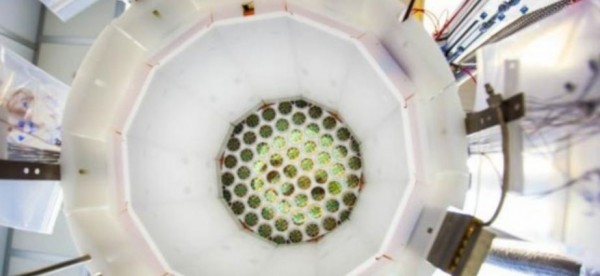Dark Matter Evades Detection by the Most Sophisticated Device in the World
| Arthur Dominic Villasanta | | Jul 23, 2016 03:52 AM EDT |
(Photo : Matthew Kapust/Sanford Underground Research Facility) The inside of the LUX detector.
The world's most sensitive instrument for detecting dark matter has failed to prove it's out there despite an intensive search that took all of 20 months.
Scientists now pin their hopes on finally detecting dark matter on the successor to the Large Underground Xenon (LUX) dark matter experiment -- LUX-Zeplin, which will have 70 times the sensitivity of its predecessor.
Like Us on Facebook
Researchers reported the letdown at the 11th Identification of Dark Matter Conference (IDM2016) in the United Kingdom that convened scientists seeking to understand dark matter.
They announced they found no hints of dark matter particles in their latest analysis despite increasing the sensitivity of the experiment fourfold for its final run.
"We built an experiment that has delivered world-leading sensitivity in multiple new results over the last three years," said physicist Rick Gaitskell of Brown University, co-spokesperson for the LUX Collaboration.
"We gave dark matter every opportunity to show up in our experiment, but it chose not to."
The failure of the LUX dark-matter detector, however, wasn't complete since it also revealed more of the possible characteristics of dark matter that will prove useful in future attempts at detection.
"LUX has delivered the world's best search sensitivity since its first run in 2013," added Gaitskell. "With this final result from the 2014 to 2016 search, the scientists of the LUX Collaboration have pushed the sensitivity of the instrument to a final performance level that is four times better than the original project goals."
LUX is a 370 kilogram liquid xenon time-projection chamber that aims to directly detect galactic dark matter in an underground laboratory 1.6 kilometers under the Earth in the Black Hills of South Dakota in the United States.
The LUX underground laboratory is called the Sanford Underground Research Facility. In it is a 1.8 meter-tall titanium tank holding 302 kg of frigid liquid xenon in which is suspended in a 272,500 liter tank of purified water.
The xenon will light up with a jolt of electrical charge and a faint flash of light caught by surrounding sensors when a dark matter particle collides with one of its atoms. The water and the rocks are there to stop anything else from penetrating and disturbing the process.
This latest result reveals nothing with the right properties to excite the xenon made it through.
"It would have been marvelous if the improved sensitivity had also delivered a clear dark matter signal," said Gaitskell. "However, what we have observed is consistent with background alone."
Tagsdark matter, Large Underground Xenon (LUX) dark matter experiment, LUX, LUX Collaboration, LUX-Zeplin, Sanford Underground Research Facilit
©2015 Chinatopix All rights reserved. Do not reproduce without permission
EDITOR'S PICKS
-

Did the Trump administration just announce plans for a trade war with ‘hostile’ China and Russia?
-

US Senate passes Taiwan travel bill slammed by China
-

As Yan Sihong’s family grieves, here are other Chinese students who went missing abroad. Some have never been found
-

Beijing blasts Western critics who ‘smear China’ with the term sharp power
-

China Envoy Seeks to Defuse Tensions With U.S. as a Trade War Brews
-

Singapore's Deputy PM Provides Bitcoin Vote of Confidence Amid China's Blanket Bans
-

China warns investors over risks in overseas virtual currency trading
-

Chinese government most trustworthy: survey
-

Kashima Antlers On Course For Back-To-Back Titles
MOST POPULAR
LATEST NEWS
Zhou Yongkang: China's Former Security Chief Sentenced to Life in Prison

China's former Chief of the Ministry of Public Security, Zhou Yongkang, has been given a life sentence after he was found guilty of abusing his office, bribery and deliberately ... Full Article
TRENDING STORY

China Pork Prices Expected to Stabilize As The Supplies Recover

Elephone P9000 Smartphone is now on Sale on Amazon India

There's a Big Chance Cliffhangers Won't Still Be Resolved When Grey's Anatomy Season 13 Returns

Supreme Court Ruled on Samsung vs Apple Dispute for Patent Infringement

Microsoft Surface Pro 5 Rumors and Release Date: What is the Latest?












